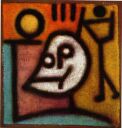|
Paul
Klee, upper right, continues to engage his fellows. Musician, painter,
craftsman, architect, creator of worlds, he seeks those who feed, share,
and actualize his vision.
Consider
his Twittering Machine: mere mechanism moving fresh harmonies. The
wire-bird quartet are each distinctive. A leading soprano darts forward,
voicing new directions. The alto, shrinking from prominence, adds
undercurrents. The tenor, an assumed favorite, keeps the quartet moving.
Unconcerned with attention, hearing best the accompanying voices, the bass
improvises uplifting support. Turn the crank, faster, slower, with
variations in speed, adding voiceings, considering accompanying
situations, voices and words, as a crank-turner you metamorphosise from a
mere technician to an actualizing composer: a fellow singer, both limited
and actualized by physics.
Klee
looks out, appreciative equally of the mechanics which enable his gestures
and the spirit which engages experimentation and actualizes performance.
How far and at what speed will the head incline or decline? What input
will shape those eyelids to output one of innumerable inviting or retarding
expressions? And how does your face form now, how does your pulse
change?
Klee’s
viaduct’s revolt, breaking free from uniformity, from subordination to
mere common function. His vision and art builds on varied influences
working fresh in new circumstances, and he is himself one of the supports,
a pipe piping new songs others may freshen. In 1937 Klee joined his
fellows in a Nazi exhibition, a display of “decadent” art. Good German citizens,
gathering for mutual satisfaction, would condemn weak individualities
which might dilute German supremacy, or prudent citizens would learn to keep any
such interests private. Germanic viaducts function by reducing every part
to collective function, each part a
replica of a functioning patriotic companion. Klee’s sense of harmony
lies elsewhere, and survives in this, among other visions, carrying
nourishment still, one among many tributaries of creative activity.
Observe
your mail: envelopes take shape, each a potential face, each a voice
capable of speech, attentive to input, actualizing fresh directions.
Each envelope exists as an unread cover, a child in need of attention. Each
envelope exists as an invitation, a speaker ready to join in group
activity. Klee’s Ghost Letter still seeks a voice. Perhaps the curlicue heart, in 1922,
utters “nein”. No may be
the prelude to fresh energies, not merely resistant to Nazi attitudes and
actions, but free from them, looking forward. Nein, of course, may also be
the extermination of such individuals, one at a time or in groups, by gas
or by conditioned repression.


Klee,
shortly before his death, offered up his Bell Angel, a figure all but
unnoticeable to those who seldom listen. This figure prefers inner
voiceings to external appearances. The bell’s motions invite
attention: what is she leaving, what will she approach? The face suggests
determination, not fear or disgust, not pleasure or approval, but inviting
determination. For those who listen, actualizing her appearance requires
actualizing her circumstances, requires sharing her current environment.
Klee’s
Death and Fire shows one of the visions in 1937 his Bell Angel
would see. “Tod” (death) appears in the landscape, the circle, and the
face. “Tod” reappears in the mouth and eyes of our companion. But the
expression shares with the bell-angel determination, inviting fellow
observers, fellow actors, to action. Resisting fascism and censorship, of
course, is a possibility. But moving on, seeking fresh creations,
stoppable perhaps, but not reducible by suppressions to come.

|